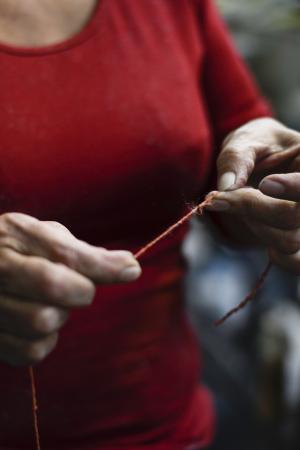
While companies and stakeholders across industries will not tire to make promises that include their willingness to become more transparent, we still see little actual progress. Research by Deloitte has shown that 65% of procurement leaders across sectors have limited or no visibility beyond their tier-1 suppliers. And only 6% of procurement leaders say they have full transparency of their entire supply chain.
Typically, the more upstream suppliers are in the value chain, the less oversight and control lead companies have over them. But this is also where the worst social and environmental impacts are often found. According to Planet Tracker, most of the clothing industry’s emissions are caused in the upstream part of the supply chain, while most of the capital is in retail. This opacity can also present a business continuity challenge: Research by ILO shows more than a third of all supply chain disruptions are caused by difficulties with indirect suppliers.
You can only improve what you know and can measure
A fundamental benefit of embarking into traceability is the opportunity to gain full visibility of the value chain, identify all suppliers and actors up to raw material providers, and proactively engage with them to prevent and mitigate environmental and social risks and impacts. It allows producers, brands, consumers, governments and regulators to have the full range of information and to tackle the complexity of current supply chains in the garment and footwear industry.
Even consumers are willing to pay a higher price for transparency: According to the 2023 PwC Global Consumer Insights Survey, 78% of consumers would pay more for products that are produced locally or made from recycled, sustainable or eco-friendly material and want to make more sustainable choices. However, more than 50% of these consumers do not trust or understand companies’ environmental claims.
If it is clear that transparency is important, what is lacking to scale it up industry-wide?
The short answer is system enablers.
In this respect, UNECE and its project “The Sustainability Pledge” are effectively preparing stakeholders, governments and actors in the textile and leather industry to take up traceability and transparency approaches, with support of advanced technologies. Its toolbox, including the Policy Recommendation N°46 implementation guidelines, traceability and information exchange standards, blockchain pilots and capacity-building, offers practical solutions to every business in the value chain no matter which size, location or stage in the chain.
How UNECE contributes to scale-up transparency and traceability in the clothing industry
In the past years, there has been fast progress in the regulatory landscape. In particular the EU Directive on corporate sustainability due diligence, announced in the beginning of 2022, is a step in the right direction to ensure transparency on a larger scale. In the same vein, the EU Directorate General for Internal Market, Industry, Entrepreneurship and SMEs (“DG GROW”) leads the Textiles Ecosystem Transition Pathway, a co-creation process among stakeholders to build a transition pathway towards a more resilient, sustainable and digital textiles ecosystem.
Under this collaborative tool, the UNECE initiative was identified as one of the key actions in 2022 to advance sustainability and digitalization in the EU textile industry by focusing on the importance of implementing a common traceability mechanism with minimum data and identification system. The Textiles Ecosystem Transition Pathway policy report will be published in March 2023, and include specific actions needed for the twin transition of the textiles ecosystem.
Furthermore, the European Commission plans to introduce the Digital Product Passport (DPP) as part of the European Green Deal. It aims to track product components and raw materials used along global value chains. According to the European Commission, “all regulated products will have Digital Product Passports. This will make it easier to repair or recycle products and facilitate tracking substances of concern along the supply chain.”
While different consumer goods possess different product information, a common dataset to ensure cross-sectoral use, interoperability and consistency in standards, systems and classifications across borders is required. This is an important area for the United Nations Centre for Trade Facilitation and Electronic Business (UN/CEFACT), an intergovernmental body of UNECE, as it provides harmonized standards and data exchange structures to help shape the ecosystem of the DPP by means of a working group. The approval of the regulation on DPPs is expected in 2024 and implementation for the first product groups in 2026.
Significant effort is also undertaken by UNECE through its recently kicked-off blockchain pilot with Stella McCartney, and the cotton supplier Söktas, to trace a T-shirt for the brand’s 2023 summer collection through documentary evidence. The pilot is exploring the use of innovative technologies such as Satellite Imagery and DNA testing to substantiate the company’s sustainability credentials, including biodiversity monitoring, water use, crop rotation as well as through other methods to measure carbon capture rate. The final results are expected to be published in spring 2023.
So far UNECE blockchain pilots that focus on end-to-end traceability and transparency have been tested in 21 countries with more than 70 partners in 13 use cases. They have shown the importance of reliable information to identify, prevent and mitigate adverse impacts on people and the planet, which is documented in a Proof-of-Concept report for consultation.
While there is considerable progress in the right direction, it is still a rocky road to globally advance transparency and traceability in the clothing industry. But one thing is for sure, UNECE will continue to be a key force to drive this change.

